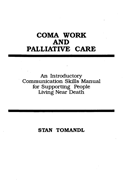
Ten Near Death and Coma Work Tips for Helpers and Family
Some of the tips we provide below may be useful for helpers and family who ponder what to do in end of life states. Follow these tips if they are useful, but please don’t use these suggestions as commandments.
Please value feeling skills or meta-skills (feeling attitudes that you bring with your deeply centered presence) as much as skills.
There are no firm procedures and may never be any fixed rules in working with people. Everything is a process; it depends upon the moment, people, belief systems, and feedback processes.
See Stan Tomandl’s Coma Work and Palliative Care, and Amy Mindell’s Coma: A Healing Journey, A Guide for Family Friends and Helpers, and Arnold Mindell’s Coma, Key to Awakening for more.
I. About Medications
At the appropriate time, when someone is nearing death, ask them if they prefer a lucid state (minimal drugs) in which they can track their experiences or a less lucid state (more drugs). Left to themselves, the majority of people do not seem to use their lucidity in comatose or near coma-like states. This may be due in part to the lack of education about death and dying and the culture someone is living in.
Giving more drugs to make the client feel “better” can be a good idea. Although the person may prefer minimal drugs, so they can access the creativity trying to happen which may enrich and facilitate the whole end of life process. Medications and awareness can work together. Drug levels may vary depending on patient’s wants and needs from day to day or within the same day.
II. Effects of Lucidity
Everyone should know that, as a general rule, more lucidity will help complete people’s processes, and be more restful and best for patients, family, and care providers.
For a description of some types of “processes” refer to Dr. Rosemary Shinkwin’s Preface to An Alzheimer’s Surprise Party.
III. Precision
For those “clients” choosing the lucid path, be absolutely precise as a helper and notice little tiny things and feed them back by repeating them verbally, by touch, or movement.
IV. Wait and Notice
What you don’t know, don’t fill in with your everyday mind; wait for answers to happen. Only after positive feedback to what you have done, go on with what you are doing. Especially in coma work and in general, if the client asks you to play a part in their process, then you can or must use your own experiences as part of the overall process. You are needed as you are! Your presence and your reactions are part of the overall dreaming field of your client and in learning how to make your reactions useful you will be guide by feedback from your client.
V. Agitation Just Before Death
To the surprise and terror of many helpers, clients near death seem to get agitated and try to fly or walk or even run from their bed. Helpful methods to work with this are to tell them you are going to fly or walk for them, and to ask them to “choreograph” you, if possible. Or, you can move their body or legs for them and ask them to imagine where they are going and what they are doing. Some folks tell you they are flying into the air, or reaching for the sun etc. (Actually helping someone out of bed is a very radical procedure and needs great care and expertise.)
VI. Respecting Death and Dying Is Very Important
Perhaps even more important however is respecting the process that is not necessarily time or space bound, here or there. Connecting with “the other side”, or past or future times may be important.
VII. About Attachment
If you are normal and attached and can’t let go, then act that out, put on a little theater, show it to the other, and then you might be able to show letting go. Many feelings we have mirror submerged feelings the client has and is shy about showing.
VIII. What to do Next?
Remember, you are the other. If your friend or client asked you to be there at the end, and you don’t know what to do, ask yourself what you would want in a given moment.
IX. Special Situation: Young Children
When dealing with very young children, especially under the age of two, we have had good responses by playing very fast and/or very slow music and simultaneously, gently tapping on their feet in rhythm with the music. Depending upon the situation, half an hour, twice a day could be helpful.
X. The Four Things: “Please forgive me,” “I forgive you,” “Thank you,” and “I love you”
These four short sentences carry the core wisdom of what people who are dying have taught Dr. Ira Byock about what matters most in life . . . Patients who used the Four Things in all sorts of life situations show the possibility of interpersonal and spiritual healing and wholeness, even in the wake tradgey or the face of death. The Four Things That Matter Most by Ira Byock, MD
Edited by ANN JACOB, STAN TOMANDL, and TOM RICHARDS from DRS. ARNOLD & AMY MINDELL, www.aamindel.net, 2006 .
* * *
Example: Recovery from Stroke and Metabolic coma
* * *
Example: Coma Work ~ One Family’s Experience with Structural Coma
* * *
Coma Work and Paliative Care ~ Communication Skills Manual
* * *
Contact Tom Richards at 847-486-8349 in Chicago, Illinois, USA
* * *
Contact Ann Jacob and Stan Tomandl at 250-592-4928 in Victoria, BC, Canada



